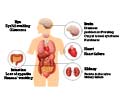A new study has uncovered how amyloid beta--the neurotoxin linked to Alzheimer's disease (AD) - forms in axons and related structures that connect neurons in the brain.

‘A new study solves the mystery of how amyloid beta forms in brain nerve cells in Alzheimer’s disease condition.’





Among his many contributions to research on AD, Rudolph Tanzi, PhD, vice chair of Neurology and co-director of the McCance Center for Brain Health at MGH, led a team in 1986 that discovered the first Alzheimer's disease gene, known as APP, which provides instructions for making amyloid protein precursor (APP). When this protein is cut (or cleaved) by enzymes--first, beta secretase, followed by gamma secretase--the byproduct is amyloid beta (sometimes shortened to Abeta). Large deposits of amyloid beta are believed to cause neurological destruction that results in AD. Amyloid beta formed in the brain's axons and nerve endings causes the worst damage in AD by impairing communication between nerve cells (or neurons) in the brain.
Researchers around the world have worked intensely to find ways to block the formation of amyloid beta by preventing cleavage by beta secretase and gamma secretase. However, these approaches have been hampered by safety issues.
Despite years of research, a major mystery has remained. "We knew that Abeta is made in the axons of the brain's nerve cells, but we didn't know how," says Tanzi. He and his colleagues probed the question by studying the brains of mice, as well as with a research tool known as Alzheimer's in a dish, a three-dimensional cell culture model of the disease created in 2014 by Tanzi and a colleague, Doo Yeon Kim, PhD.
Earlier, in 2013, several other MGH researchers, including neurobiologist Dora Kovacs, PhD (who is married to Tanzi), and Raja Bhattacharyya, PhD, a member of Tanzi's lab, showed that a form of APP that has undergone a process called palmitoylation (palAPP) gives rise to amyloid beta. That study indicated that, within the neuron, palAPP is transported in a fatty vesicle (or sac) known as a lipid raft.
Advertisement
The new investigation revealed that palAPP is stabilized and prepared for cleavage by beta secretase in special lipid rafts within the neuron known as mitochondria-associated endoplasmic reticulum membranes (MAMs). "We showed for the first time not only that the MAM is where palAPP is processed by beta secretase to make Abeta, but that this happens exclusively in axons and neuronal processes where Abeta does most of its damage," says Bhattacharyya, lead author of the Cell Reports paper.
Next, the MGH team wanted to learn what happens when MAM levels and activity were intentionally altered. They showed for the first time that preventing assembly of MAMs, either with gene therapy or a drug that blocked a key protein called the sigma-1 receptor (S1R), dramatically decreased beta secretase cleavage of palAPP in axons and lowered Abeta production.
Conversely, a drug that activated S1R triggered an increase in beta secretase cleavage of palAPP and increased production of amyloid beta in axons.
"Our results suggest that the sigma-1 receptor might be a viable therapeutic target for reducing Abeta production, specifically in axons," says Tanzi. The study also lends support for a strategy already under investigation by Tanzi and his team, which is developing an experimental treatment that inhibits the palmitoylation of APP, the process that produces palAPP. It's also known that another class of drugs that Kovacs is studying for preventing formation of amyloid beta, called ACAT inhibitors, works directly in MAMs.
In the future, these and other interventions that thwart production of this most dangerous pool of axonal amyloid beta could be used in concert with early detection (through blood or imaging tests) to stop or slow the progression of AD.
Source-Eurekalert















